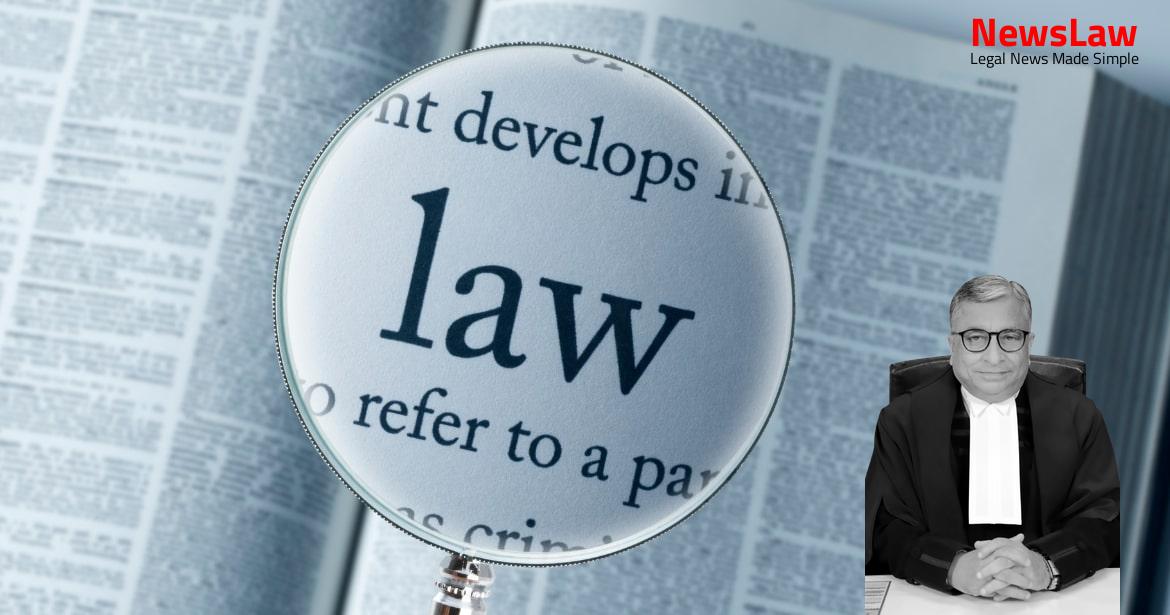The court’s thorough legal analysis in a capital punishment case sheds light on the complexities of sentencing and conviction. The judgment delves into the nuances of the law, weighing mitigating factors against the severity of the crime. This summary focuses on the court’s reasoning and conclusions, providing valuable insights into the legal process surrounding such cases.
Facts
- The judgment affirms the appellant’s conviction under Sections 302, 376, 364, 366A, and 201 of the Indian Penal Code, 1860, with varying sentences.
- The appellant, Irappa Siddappa Murgannavar, received the death sentence for the offense under Section 302.
- The prosecution’s case includes allegations of rape, murder by strangulation, and disposal of the body in a stream named Bennihalla.
- Three main circumstances form the crux of the case: the appellant taking the deceased R from a neighbor’s house, being seen carrying her towards Bennihalla, and the recovery of R’s body from Bennihalla based on the appellant’s disclosure statement.
- R, a 5-year-old girl, was living with her maternal grandfather while her parents worked in another city.
- The High Court of Karnataka at Dharwad passed the judgment on 6 March 2017.
- Multiple witnesses testified to the appellant’s actions on December 28, 2010, leading up to the disappearance of R.
- Witnesses saw the appellant carrying R in a gunny bag towards Bennihalla stream, further indicating his involvement.
- Search efforts were made by family and villagers upon R’s disappearance, with unsuccessful results.
- The appellant’s arrest on January 1, 2011, was accompanied by a disclosure statement confessing to disposing of R’s body in the waters of Bennihalla.
- Evidence of the discovery of R’s body along with two stones in a gunny bag was presented by witnesses and the investigating officer.
Also Read: Land Auction Dispute Resolution
Arguments
- The State has contended that contradictions in witness statements should have been brought up during cross-examination by the defence.
- The State justifies the death sentence by citing the gravity of the crime and its impact on societal morals.
- Mitigating factors listed by the appellant for commutation of the death sentence include the murder not being pre-planned.
- The appellant challenges the sentencing procedure on the grounds of the High Court not hearing him separately on sentencing and failing to consider mitigating circumstances.
- The appellant argues against the State’s stance on the severity of the crime, emphasizing the need for confronting witnesses by the defence to exploit inconsistencies.
Also Read: Analysis of Bail Conditions in Criminal Appeal No. INSC 48/2024
Analysis
- The appellant had no criminal antecedents and no evidence proving pre-planned commission of the offence.
- The dead body was concealed and immersed in the stream with stones, indicating potential foul play by the appellant.
- Statements of witnesses supported the recovery of the dead body based on the appellant’s disclosure statement.
- The High Court and District Court’s conviction for rape and murder was upheld.
- The appellant sentenced to death, with additional prison sentences confirmed by the High Court.
- Village communities’ trust initially shielded suspicions of the appellant’s involvement.
- Date discrepancies in witness testimony explained as memory lapse, not affecting the prosecution’s case.
- Evidence of ‘last seen’ with the appellant shaky and doubtful.
- Statements made by witnesses were considered inconsistent due to passage of time and rural setting.
- The appellant was given ample opportunity to present materials in his defense.
- Appellant’s involvement in the crime convincingly established through witness testimonies and prosecution’s evidence.
- Medical evidence supported the prosecution’s claim of rape and murder.
- The appellant’s behavior in prison reflected a desire for reformation and humane behavior.
- Several mitigating factors weighed against imposing the death penalty on the appellant.
- The conduct of witnesses and evidence corroborated recovery of the body based on the appellant’s statement.
- The trial court’s reasoning for awarding the death sentence was based on the brutal nature of the crime.
- Various factors influenced the decision to confirm the death sentence, emphasizing the severity of the crime.
- Contradictions and inconsistencies in the prosecution’s case were highlighted by the appellant’s counsel.
- Out of the remaining 12 cases, there was no indication of criminal antecedents of the appellant or a grave danger to society.
- In 12 cases out of 51, the death sentence was initially awarded, but in 3 cases, the sentence was commuted to life imprisonment upon review.
- The case of Bantu alias Naresh Giri v. State of Madhya Pradesh determined that the appellant’s act, though heinous, was not rarest of the rare necessitating his elimination from society.
- Shatrughna Baban Meshram surveyed 67 judgments where death sentences were imposed for offenses under Sections 376 and 302 of the Code when victims were below 16 years old.
- In Shanti Devi v. State of Rajasthan, recovery of the deceased’s body at the accused’s instance was a crucial circumstance leading to conviction and imposition of the death sentence.
- The five-fold test by Fazal Ali J. in Sharad Birdhichand Sarda v. State of Maharashtra was satisfied, ensuring the appellant’s guilt was established with conclusive evidence.
- Dagdu highlighted the duty of the appeal court to offer the accused an opportunity to present materials for sentencing if Section 235(2) CrPC was not complied with.
- Uday U. Lalit, J. in Shatrughna Baban Meshram v. State of Maharashtra observed that mere infraction of Section 235(2) should not automatically commute the death sentence to life imprisonment.
- This Court affirmed death sentences in 15 out of 67 cases reviewed, with two cases confirming death penalties upon review.
- Santa Singh v. State of Punjab addressed the infraction of Section 235(2) leading to the setting aside of the death sentence and remanding of the case.
- Dagdu and Others v. State of Maharashtra clarified that the failure of the trial court to consider the accused on sentencing does not always necessitate a remand.
- In Ranjit Kumar Haldar v. State of Sikkim, the recovery of the dead body based on the accused’s statement was a critical incriminating circumstance supporting her conviction.
- The appellant committed an abhorrent crime, leading to a sentence of life imprisonment.
- There is no material indicating he poses a serious threat to society if allowed to live.
- Life imprisonment is deemed sufficient punishment and penitence for his actions.
- Hope for reformation and rehabilitation exists, making life imprisonment a viable option.
- Other sentences will run concurrently, not consecutively.
- The death sentence imposed by lower courts is commuted to life imprisonment.
- The appellant is not entitled to premature release/remission for at least thirty years.
Also Read: Conviction Upheld for Murder and Concealment of Body
Decision
- The appellant has been sentenced to imprisonment for life for the offence under section 376 of the Code, which sentence is also imposed for the offence under section 302 of the Code.
- Conviction upheld for offences under Sections 302, 376, 364, 366A and 201 of the Code.
- Sentences for the offences under Sections 376, 364, 366A and 201 of the Code run concurrently, not consecutively.
- Death sentence commuted to life imprisonment.
- Appellant not entitled to premature release/remission before serving 30 years for offence under Section 302 of the Code.
- Appeals partly allowed and disposed of along with pending applications.
Case Title: IRAPPA SIDDAPPA MURGANNAVAR Vs. THE STATE OF KARNATAKA (2021 INSC 707)
Case Number: Crl.A. No.-001473-001474 / 2017



